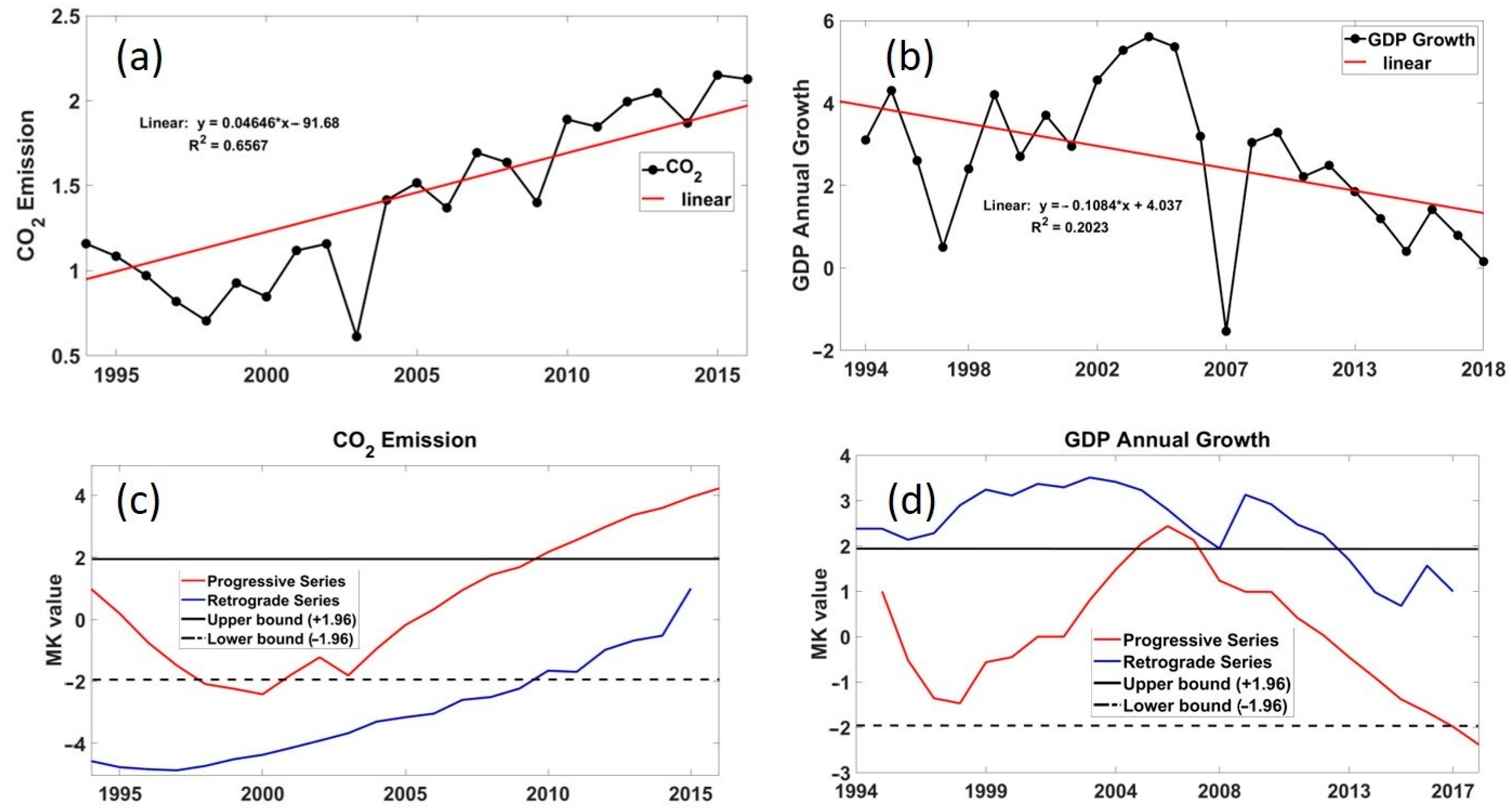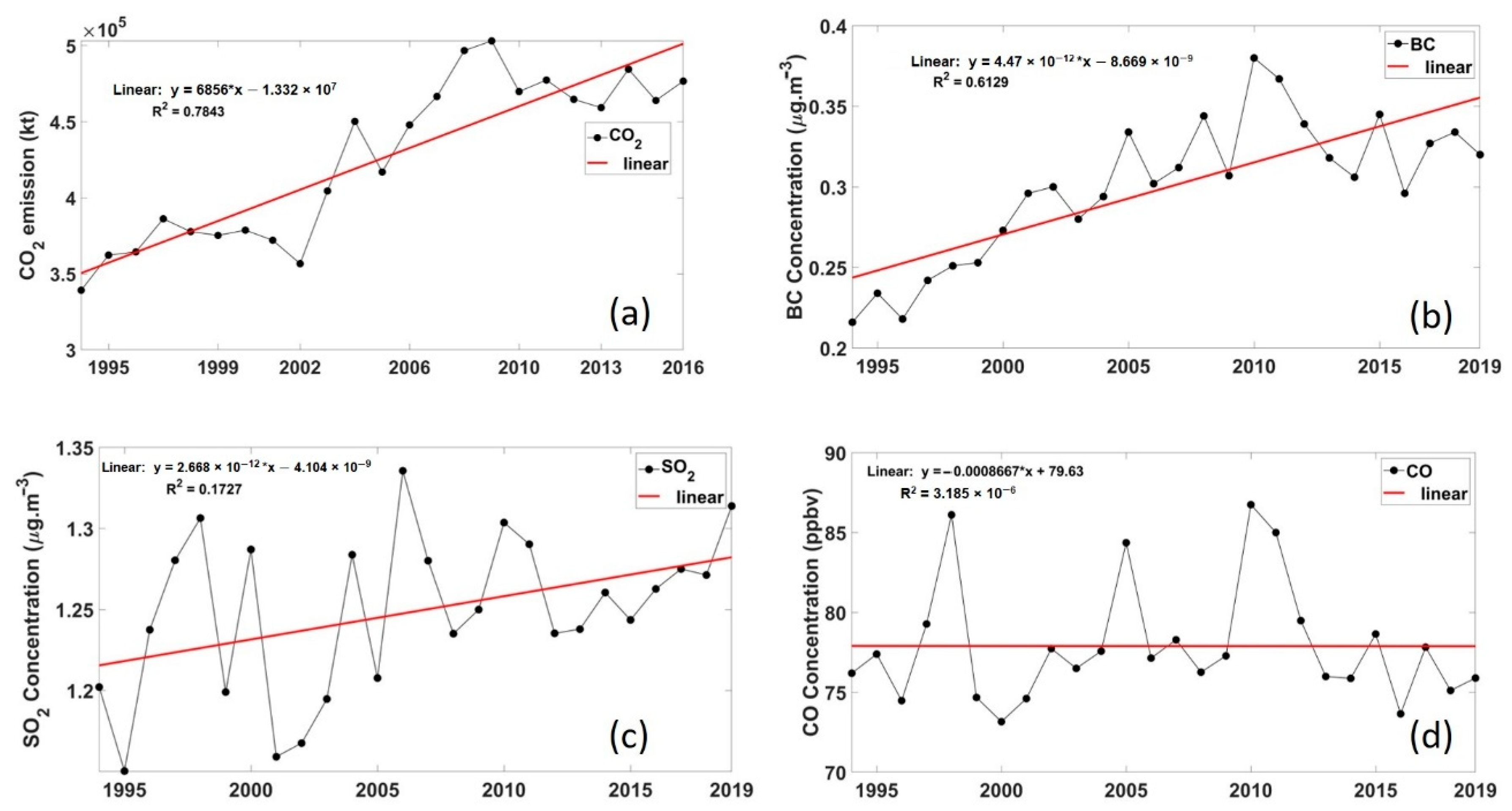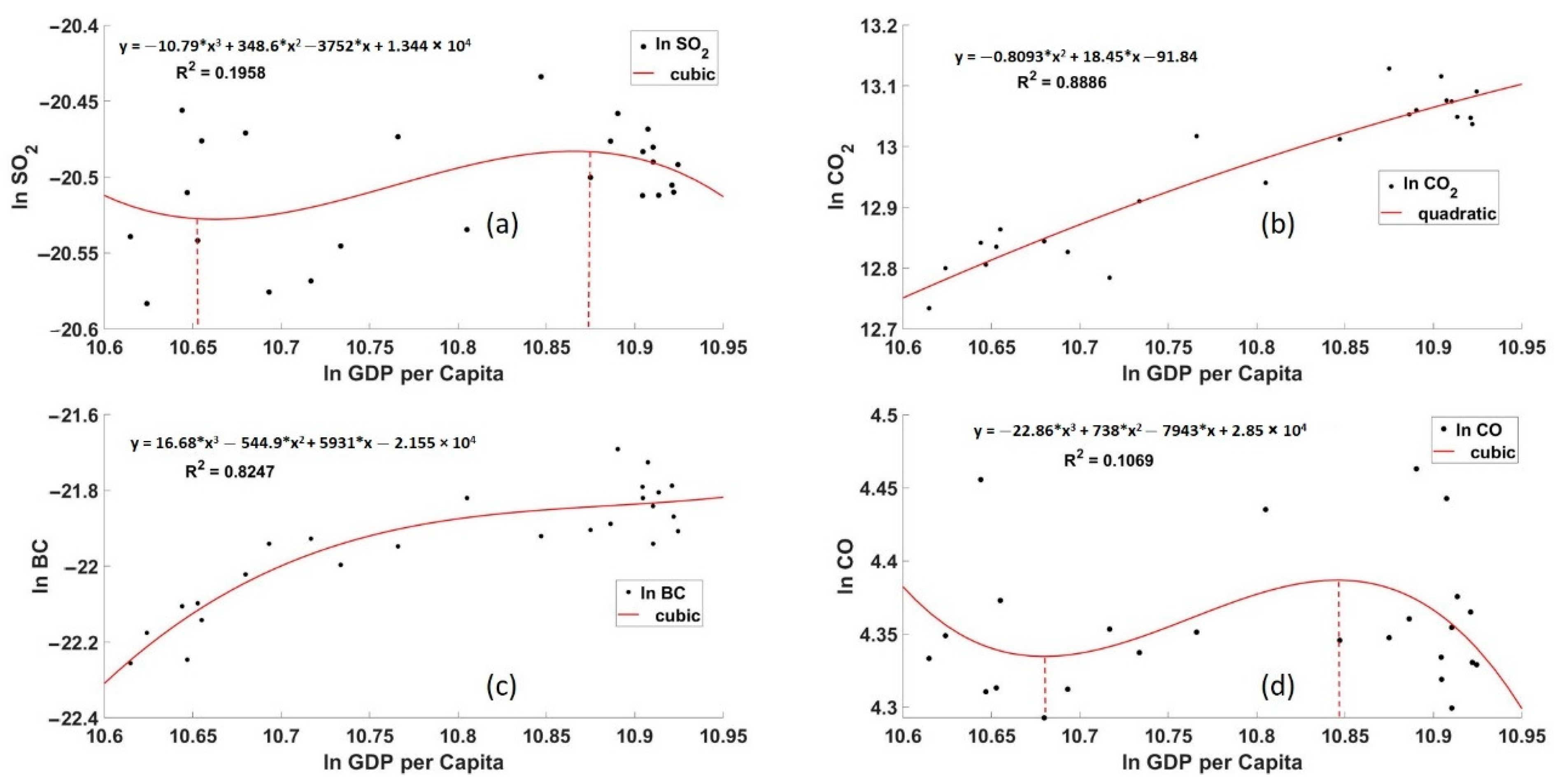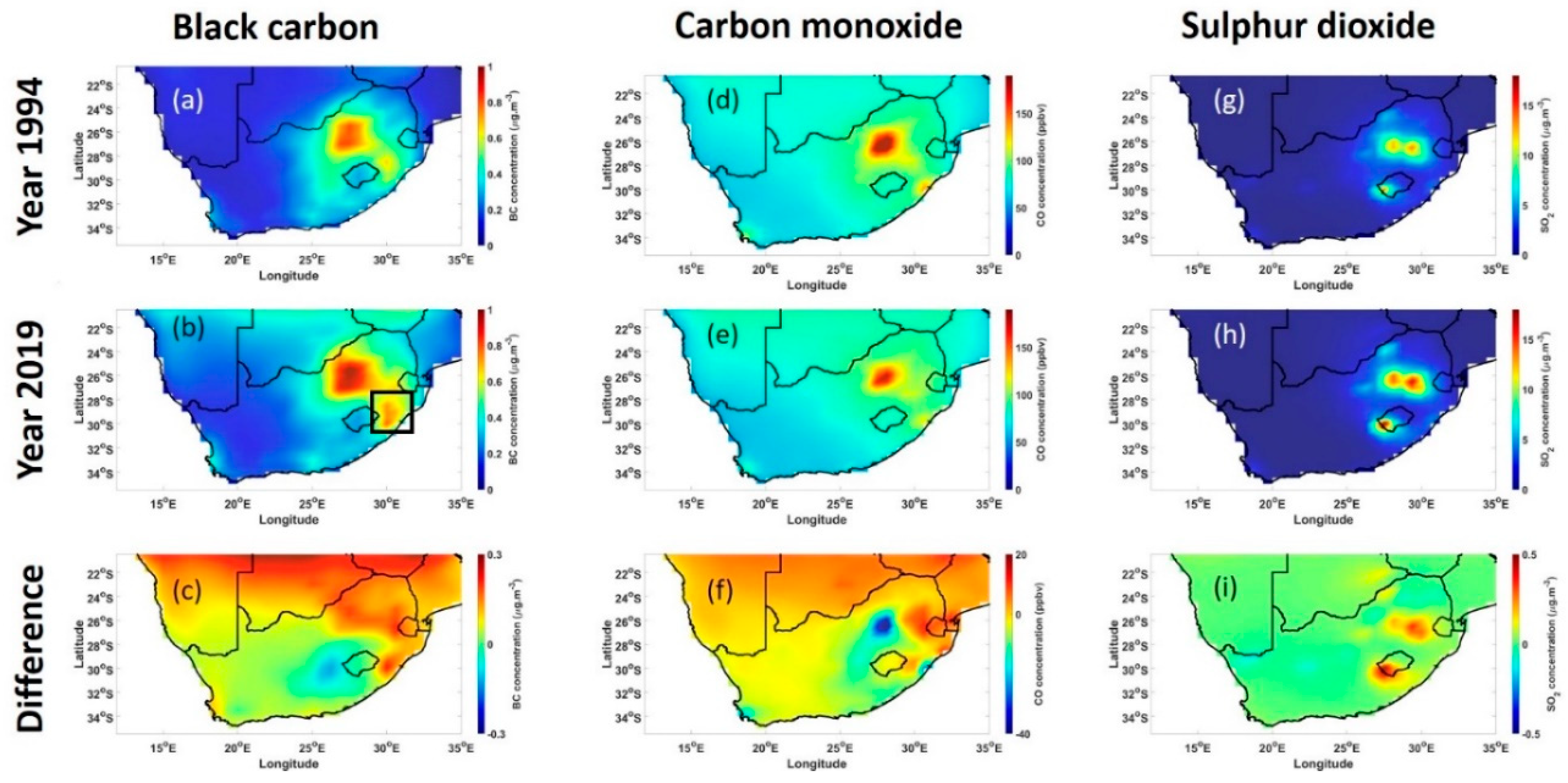Assessing the Relationship between Economic Growth and Emissions Levels in South Africa between 1994 and 2019
Abstract
1. Introduction
2. Description of the Study Area
3. Data and Methodology
3.1. World Bank Indicators
3.2. MERRA-2
3.3. Linear Regression
3.4. SQ-MK Test
- At each comparison, the number of cases xi > xj is counted and indicated by , where xi (i = 1, 2, …, n) and xj (1,2, …, n) are the sequential values in a series, respectively.
- The test statistic ti is calculated by
- The mean E(t) and the variance var(ti) of the test statistic are calculated by
- Sequential progressive value can be calculated as
3.5. Environmental Kuznets Curve Hypothesis
4. Results and Discussions
4.1. CO2 Emissions and GDP Annual Growth
4.2. Emissions: Linear and SQ-MK Trends
4.3. Pollutants and GDP Correlation
4.4. EKC Relationship between GDP per Capita and Pollutants
4.5. Spatial Distribution of Pollutants and Meteorological Conditions over South Africa
5. Summary
Author Contributions
Funding
Institutional Review Board Statement
Informed Consent Statement
Data Availability Statement
Acknowledgments
Conflicts of Interest
References
- Dong, K.; Dong, X.; Jiang, Q. How renewable energy consumption lower global CO2 emissions? Evidence from countries with different income levels. World Econ. 2020, 43, 1665–1698. [Google Scholar] [CrossRef]
- Dong, K.; Dong, X.; Dong, C. Determinants of the global and regional CO2 emissions: What causes what and where? Appl. Econ. 2019, 51, 5031–5044. [Google Scholar] [CrossRef]
- Waheed, R.; Sarwar, S.; Wei, C. The survey of economic growth, energy consumption and carbon emission. Energy Rep. 2019, 5, 1103–1115. [Google Scholar] [CrossRef]
- Salahuddin, M.; Khan, S. Empirical link between economic growth, energy consumption and CO2 emission in Australia. J. Dev. Areas 2013, 47, 81–92. [Google Scholar] [CrossRef]
- Esseghir, A.; Khouni, L.H. Economic growth, energy consumption and sustainable development: The case of the Union for the Mediterranean countries. Energy 2014, 71, 218–225. [Google Scholar] [CrossRef]
- Saboori, B.; Sapri, M.; bin Baba, M. Economic growth, energy consumption and CO2 emissions in OECD (Organization for Economic Co-operation and Development)’s transport sector: A fully modified bi-directional relationship approach. Energy 2014, 66, 150–161. [Google Scholar] [CrossRef]
- Zhang, X.P.; Cheng, X.M. Energy consumption, carbon emissions, and economic growth in China. Ecol. Econ. 2009, 68, 2706–2712. [Google Scholar] [CrossRef]
- Esso, L.J.; Keho, Y. Energy consumption, economic growth and carbon emissions: Cointegration and causality evidence from selected African countries. Energy 2016, 114, 492–497. [Google Scholar] [CrossRef]
- Kijima, M.; Nishide, K.; Ohyama, A. Economic models for the environmental Kuznets curve: A survey. J. Econ. Dyn. Control. 2010, 34, 1187–1201. [Google Scholar] [CrossRef]
- Sobhee, S.K. The environmental Kuznets curve (EKC): A logistic curve? Appl. Econ. Lett. 2004, 11, 449–452. [Google Scholar] [CrossRef]
- Al Sayed, A.R.; Sek, S.K. Environmental Kuznets curve: Evidences from developed and developing economies. Appl. Math. Sci. 2013, 7, 1081–1092. [Google Scholar] [CrossRef]
- Farhani, S.; Mrizak, S.; Chaibi, A.; Rault, C. The environmental Kuznets curve and sustainability: A panel data analysis. Energy Policy 2014, 71, 189–198. [Google Scholar] [CrossRef]
- De Bruyn, S.M.; van den Bergh, J.C.; Opschoor, J.B. Economic growth and emissions: Reconsidering the empirical basis of environmental Kuznets curves. Ecol. Econ. 1998, 25, 161–175. [Google Scholar] [CrossRef]
- Kumar, K.K.; Viswanathan, B. Changing structure of income indoor air pollution relationship in India. Energy Policy 2007, 35, 5496–5504. [Google Scholar] [CrossRef]
- Farhani, S.; Ozturk, I. Causal relationship between CO2 emissions, real GDP, energy consumption, financial development, trade openness, and urbanization in Tunisia. Environ. Sci. Pollut. Res. 2015, 22, 15663–15676. [Google Scholar] [CrossRef] [PubMed]
- Ozturk, I.; Al-Mulali, U. Investigating the validity of the environmental Kuznets curve hypothesis in Cambodia. Ecol. Indic. 2015, 57, 324–330. [Google Scholar] [CrossRef]
- Li, T.; Wang, Y.; Zhao, D. Environmental Kuznets curve in China: New evidence from dynamic panel analysis. Energy Policy 2016, 91, 138–147. [Google Scholar] [CrossRef]
- Wang, Z.; Bao, Y.; Wen, Z.; Tan, Q. Analysis of relationship between Beijing’s environment and development based on Environmental Kuznets Curve. Ecol. Indic 2016, 67, 474–483. [Google Scholar] [CrossRef]
- Zhang, Y.; Chen, X.; Wu, Y.; Shuai, C.; Shen, L. The environmental Kuznets curve of CO2 emissions in the manufacturing and construction industries: A global empirical analysis. Environ. Impact Assess. Rev 2019, 79, 106303. [Google Scholar] [CrossRef]
- Stern, D.I. The rise and fall of the environmental Kuznets curve. World Dev. 2004, 32, 1419–1439. [Google Scholar] [CrossRef]
- Oraby, T.; Bauch, C.T.; Anand, M. The environmental Kuznets curve fails in a globalized socio-ecological metapopulation: A sustainability game theory approach. In Handbook of Statistics; Arni, S.R., Rao, S., Rao, C.R., Eds.; Elsevier: Amsterdam, The Netherlands, 2020; Volume 39, pp. 315–341. [Google Scholar]
- Menyah, K.; Wolde-Rufael, Y. Energy consumption, pollutant emissions and economic growth in South Africa. Energy Econ. 2010, 32, 1374–1382. [Google Scholar] [CrossRef]
- Bekun, F.V.; Emir, F.; Sarkodie, S.A. Another look at the relationship between energy consumption, carbon dioxide emissions, and economic growth in South Africa. Sci. Total. Environ. 2019, 655, 759–765. [Google Scholar] [CrossRef] [PubMed]
- Hossain, M.S. Panel estimation for CO2 emissions, energy consumption, economic growth, trade openness and urbanization of newly industrialized countries. Energy Policy 2011, 39, 6991–6999. [Google Scholar] [CrossRef]
- Odhiambo, N.M. Electricity consumption and economic growth in South Africa: A trivariate causality test. Energy Econ. 2009, 31, 635–640. [Google Scholar] [CrossRef]
- Winkler, H. Energy policies for sustainable development in South Africa. Energy Sustain. Dev. 2007, 11, 26–34. [Google Scholar] [CrossRef]
- Ding, Y.; Zhang, M.; Chen, S.; Wang, W.; Nie, R. The environmental Kuznets curve for PM2.5 pollution in Beijing-Tianjin-Hebei region of China: A spatial panel data approach. J. Clean. Prod. 2019, 220, 984–994. [Google Scholar] [CrossRef]
- Dong, Q.; Lin, Y.; Huang, J.; Chen, Z. Has urbanization accelerated PM2.5 emissions? An empirical analysis with cross-country data. China Econ. Rev. 2020, 59, 101381. [Google Scholar] [CrossRef]
- Seymore, R.; Inglesi-Lotz, R.; Blignaut, J. A greenhouse gas emissions inventory for South Africa: A comparative analysis. Renew. Sustain. Energy Rev. 2014, 34, 371–379. [Google Scholar] [CrossRef]
- World Bank. 2020. Available online: https://data.worldbank.org/country/south-africa?view=chart (accessed on 5 December 2020).
- Lequiller, F.; Blades, D. Understanding National Accounts; OECD Organization for Economic Co-operation and Development: Paris, France, 2012. [Google Scholar]
- Allen, M.R.; Frame, D.J.; Huntingford, C.; Jones, C.D.; Lowe, J.A.; Meinshausen, M.; Meinshausen, N. Warming caused by cumulative carbon emissions towards the trillionth tonne. Nature 2009, 458, 1163–1166. [Google Scholar] [CrossRef]
- Zhang, Y.-J.; Da, Y.-B. The decomposition of energy-related carbon emission and its decoupling with economic growth in China. Renew. Sustain. Energy Rev. 2015, 41, 1255–1266. [Google Scholar] [CrossRef]
- Manabe, S. Role of greenhouse gas in climate change. Tellus A Dyn. Meteorol. Oceanogr. 2019, 71, 71. [Google Scholar] [CrossRef]
- IPCC. 2005. Available online: https://www.ipcc.ch/site/assets/uploads/2018/03/srccs_chapter2-1.pdf (accessed on 7 December 2020).
- Gale, J. Overview of CO2 emissions sources, potential, transport and geographical distribution of storage possibilities. In Proceedings of the Workshop on CO2 Dioxide Capture and Storage, Regina, SK, Canada, 18–21 November 2002; pp. 15–29. [Google Scholar]
- Rienecker, M.M.; Suarez, M.J.; Gelaro, R.; Todling, R.; Bacmeister, J.; Liu, E.; Bosilovich, M.G.; Schubert, S.D.; Takacs, L.; Kim, G.; et al. MERRA: NASA’s Modern-Era Retrospective Analysis for Research and Applications. J. Clim. 2011, 24, 3624–3648. [Google Scholar] [CrossRef]
- Gelaro, R.; McCarty, W.; Suárez, M.J.; Todling, R.; Molod, A.; Takacs, L.; Randles, C.A.; Darmenov, A.; Bosilovich, M.G.; Reichle, R.; et al. The Modern-Era Retrospective Analysis for Research and Applications, Version 2 (MERRA-2). J. Clim. 2017, 30, 5419–5454. [Google Scholar] [CrossRef] [PubMed]
- Molod, A.; Takacs, L.; Suarez, M.; Bacmeister, J. Development of the GEOS-5 atmospheric general circulation model: Evolution from MERRA to MERRA2. Geosci. Model Dev. 2015, 8, 1339–1356. [Google Scholar] [CrossRef]
- Rienecker, M.; Suarez, M.; Todling, R.; Bacmeister, J.; Takacs, L.; Liu, H.-C.; Gu, W.; Sienkiewicz, M.; Koster, R.; Gelaro, R. The GEOS-5 Data Assimilation System—Documentation of Versions 5.0. 1, 5.1. 0, and 5.2. 0; Technical Report Series on Global Modeling and Data Assimilation; NASA: Washington, DC, USA, 2008. [Google Scholar]
- Wargan, K.; Labow, G.; Frith, S.; Pawson, S.; Livesey, N.; Partyka, G. Evaluation of the Ozone Fields in NASA’s MERRA-2 Reanalysis. J. Clim. 2017, 30, 2961–2988. [Google Scholar] [CrossRef] [PubMed]
- Randles, C.A.; da Silva, A.M.; Buchard, V.; Colarco, P.R.; Darmenov, A.; Govindaraju, R.; Smirnov, A.; Holben, B.; Ferrare, R.; Hair, J.; et al. The MERRA-2 Aerosol Reanalysis, 1980 Onward. Part I: System Description and Data Assimilation Evaluation. J. Clim. 2017, 30, 6823–6850. [Google Scholar] [CrossRef]
- Buchard, V.; Randles, C.A.; da Silva, A.M.; Darmenov, A.; Colarco, P.R.; Govindaraju, R.; Ferrare, R.; Hair, J.; Beyersdorf, A.J.; Ziemba, L.D.; et al. The MERRA-2 Aerosol Reanalysis, 1980 Onward. Part II: Evaluation and Case Studies. J. Clim. 2017, 30, 6851–6872. [Google Scholar] [CrossRef]
- Wishart, J. The mean and second moment coefficient of the multiple correlation coefficient, in samples from a normal population. Biometrika 1931, 22, 353–376. [Google Scholar] [CrossRef]
- Olkin, I.; Finn, J.D. Correlations redux. Psychol. Bull. 1995, 118, 155–164. [Google Scholar] [CrossRef]
- Sneyers, R. On the Statistical Analysis of Series of Observations World Meteorological Organization (WMO); Technical Note No. 143; WHO: Geneva, Switzerland, 1990. [Google Scholar]
- Sneyers, R. Climate chaotic instability: Statistical determination and theoretical background. Environmetrics 1997, 8, 517–532. [Google Scholar] [CrossRef]
- Sneyers, R.; Tuomenvirta, H.; Heino, R. Observations inhomogeneities and detection of climate change the case of the Oulu (Finland) air temperature series. Trans. Res. Rec. J. Trans. Res. Board 1998, 34, 159–178. [Google Scholar]
- Mosmann, V.; Castro, A.; Fraile, R.; Dessens, J.; Sanchez, J. Detection of statistically significant trends in the summer precipitation of mainland Spain. Atmos. Res. 2004, 70, 43–53. [Google Scholar] [CrossRef]
- Kaika, D.; Zervas, E. The Environmental Kuznets Curve (EKC) theory—Part A: Concept, causes and the CO2 emissions case. Energy Policy 2013, 62, 1392–1402. [Google Scholar] [CrossRef]
- Marquard, A.; Bekker, B.; Eberhard, A.; Gaunt, T. South Africa’s Electrification Project: An Overview and Assessment (Working Paper); University of Cape Town: Rondebosch, South Africa, 2007. [Google Scholar]
- Shikwambana, L.; Mhangara, P.; Mbatha, N. Trend analysis and first time observations of sulphur dioxide and nitrogen dioxide in South Africa using TROPOMI/Sentinel-5P data. Int. J. Appl. Earth Obs. 2020, 9, 102130. [Google Scholar] [CrossRef]
- Hersey, S.P.; Garland, R.M.; Crosbie, E.; Shingler, T.; Sorooshian, A.; Piketh, S.; Burger, R. An overview of regional and local characteristics of aerosols in South Africa using satellite, ground, and modeling data. Atmos. Chem. Phys. 2015, 15, 4259–4278. [Google Scholar] [CrossRef] [PubMed]
- Venter, A.D.; Vakkari, V.; Beukes, J.P.; van Zyl, P.G.; Laakso, H.; Mabaso, D.; TiittaI, P.; Josipovic, M.; KulmalaII, M.; Pienaar, J.J.; et al. An air quality assessment in the industrialised western Bushveld igneous complex, South Africa. S. Afr. J. Sci. 2012, 108, 1–10. [Google Scholar] [CrossRef]
- Shikwambana, L.; Tsoeleng, T. Impacts of population growth and land use on air quality. A case study of Tshwane, Rustenburg and Emalahleni, South Africa. S. Afr. Geogr. J. 2020, 102, 209–222. [Google Scholar] [CrossRef]
- Grossman, G.M.; Krueger, A.B. Economic growth and the environment. Q. J. Econ. 1995, 110, 353–377. [Google Scholar] [CrossRef]
- Panayotou, T. Demystifying the environmental Kuznets curve: Turning a black box into a policy tool. Environ. Dev. Econ. 1997, 2, 465–484. [Google Scholar] [CrossRef]
- Eggoh, J.C.; Bangaké, C.; Rault, C. Energy consumption and economic growth revisited in African countries. Energy Policy 2011, 39, 7408–7421. [Google Scholar] [CrossRef]
- Bah, M.M.; Azam, M. Investigating the relationship between electricity consumption and economic growth: Evidence from South Africa. Renew. Sustain. Energy Rev. 2017, 80, 531–537. [Google Scholar] [CrossRef]






| World Development Indicators | Indicator Value (Start Year) | Indicator Value (End Year) | Change (%) |
|---|---|---|---|
| Population | 40,564,059 (1994) | 57,779,622 (2018) | +29.80 |
| CO2 emissions from solid fuel consumption (kt) | 299,443.553 (1994) | 399,603.991 (2016) | +25.07 |
| Access to electricity (% of population) | 57.60 (1996) | 91.23 (2018) | +36.86 |
| GDP growth (annual %) | 3.200 (1994) | 0.787 (2018) | −306.7 |
| Input Data Source (Temporal Resolution, Spatial Resolution) | Products Used | Period of Analysis |
|---|---|---|
| MERRA-2 (monthly; 0.5° × 0.625°) | BC (µg·m−3) SO2 (µg·m−3) CO (µg·m−3) | 1994–2019 |
| World bank Indicators | GDP annual growth CO2 emission (kt) | 1994–2018 1994–2016 |
Publisher’s Note: MDPI stays neutral with regard to jurisdictional claims in published maps and institutional affiliations. |
© 2021 by the authors. Licensee MDPI, Basel, Switzerland. This article is an open access article distributed under the terms and conditions of the Creative Commons Attribution (CC BY) license (http://creativecommons.org/licenses/by/4.0/).
Share and Cite
Shikwambana, L.; Mhangara, P.; Kganyago, M. Assessing the Relationship between Economic Growth and Emissions Levels in South Africa between 1994 and 2019. Sustainability 2021, 13, 2645. https://doi.org/10.3390/su13052645
Shikwambana L, Mhangara P, Kganyago M. Assessing the Relationship between Economic Growth and Emissions Levels in South Africa between 1994 and 2019. Sustainability. 2021; 13(5):2645. https://doi.org/10.3390/su13052645
Chicago/Turabian StyleShikwambana, Lerato, Paidamwoyo Mhangara, and Mahlatse Kganyago. 2021. "Assessing the Relationship between Economic Growth and Emissions Levels in South Africa between 1994 and 2019" Sustainability 13, no. 5: 2645. https://doi.org/10.3390/su13052645
APA StyleShikwambana, L., Mhangara, P., & Kganyago, M. (2021). Assessing the Relationship between Economic Growth and Emissions Levels in South Africa between 1994 and 2019. Sustainability, 13(5), 2645. https://doi.org/10.3390/su13052645






